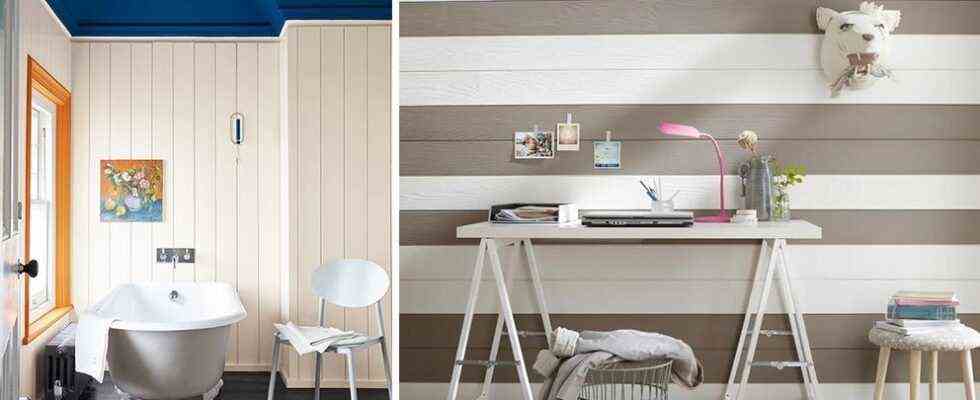1 – Choose a suitable paint
As always in painting, to obtain an irreproachable and durable result, it is essential to select the product that you are going to use.

The special paint for paneling renovation – sometimes simply stamped “special paneling” – is the perfect choice. This type of paint offers a high coverage, and it has the advantage of being suitable for all types of paneling : whether in wood or pvc, raw, painted or varnished. In addition to excellent adhesion, this paint has a good impact resistance and she is washable. The only downside: painting for paneling costs more – count around 20 € / L.
Acrylic paint seduced by its ease of use. It dries quickly, and tools can be cleaned with water. However, it is not washable: it is therefore not suitable for all rooms of the house.
Glycero paint benefits from superior resistance. It is therefore perfectly suited to the kitchen or the bathroom. On the other hand, despite strict regulations, it contains toxic products, and moreover harmful to the environment. It is therefore advisable to work in a well ventilated space, including during the drying phase of the paint.
For reconcile color and wood effect, bet on stain: far from being confined to natural shades such as oak or walnut, it comes in a pretty palette of colors of varying intensity.
2 – Choose a finish suitable for your paneling
The matte finish is currently on the rise. However, when choosing the paint finish for the paneling, it is also a matter of thinking about practicality.

THE’matt appearance is ideal for hide any faults of the surface of your paneling. However, they are reserved for the bedroom or living room, because this type of paint is relatively fragile. In damp rooms, we prefer a glossy finish, more robust. On the other hand, the glossy paint brings out the slightest roughness: it therefore requires impeccable support.
3 – Prepare the support well
If your paneling is raw, all you need to do is dust it off carefully before painting it. On the other hand, if your paneling has been varnished previously, it is essential to sand it so that the paint hangs correctly.
If you have opted for a special paneling paint, you can apply the product directly, without underlay. In the case of an acrylic or glycerol paint, on the other hand, the stage of the undercoat is essential to benefit from a satisfactory rendering.
Apply the paint with a brush in the corners, and using a roller with medium nap on the surface.
4 – choose the right color
White is a classic option for revamping a paneled interior because it is very bright.

If it is versatile, the paneling, revamped in white, lends itself more particularly to a bohemian or Scandinavian-inspired decoration, or to a romantic shabby chic atmosphere.

To keep a good light taking advantage of a cozy atmosphere, choose shades ranging from ecru to beige.

To bring a contemporary touch With a rustic paneled interior, we fall for gray – elegant, timeless and yet formidably trendy.

Adept of color? In a space lacking in natural light, especially under the eaves, go for a pastel shade to breathe new life into your paneling.

Muted or dark colors are ideal for revamping a paneling that has small defects, because they perfectly conceal any traces of impact and roughness.

Very trendy, brown is ideal for revamping the paneling of a space dedicated to reflection, such as the office or a reading corner.

As part of a renovation, it is common to have to deal with different materials, including paneling, in one room. For standardize the whole, dare a strong color, such as sun yellow.
5 – Daring an offbeat application
The trend is no longer for uniform walls. And not only does a support such as the paneling allow some fantasies, but in addition, its structure facilitates style effects !

the contrasting paneling is a classic, but it works every time. This choice is all the more relevant if your interior has interesting features, such as moldings.

The monochrome is one of the current trends in painting. It is a safe option if you want repaint the paneling without risking the lack of taste.

When it is laid horizontally, the paneling makes it easy to a base. When they do not exist, you can even take the opportunity to draw skirting boards. This type of effect, very easy to achieve, creates a very cozy atmosphere.

The stripes have a double advantage: they visually enlarge the room, and they energize the decor. Nothing could be easier than to create them by repainting your paneling!

Painting the paneling is a perfect opportunity to embrace the color block trend at home. We gladly play it in the children’s room, a space that lends itself to a decoration full of gaiety!

For a truly original decoration, darecombination of raw wood and paint, by composing a wall motif using stencils or masking tape!

